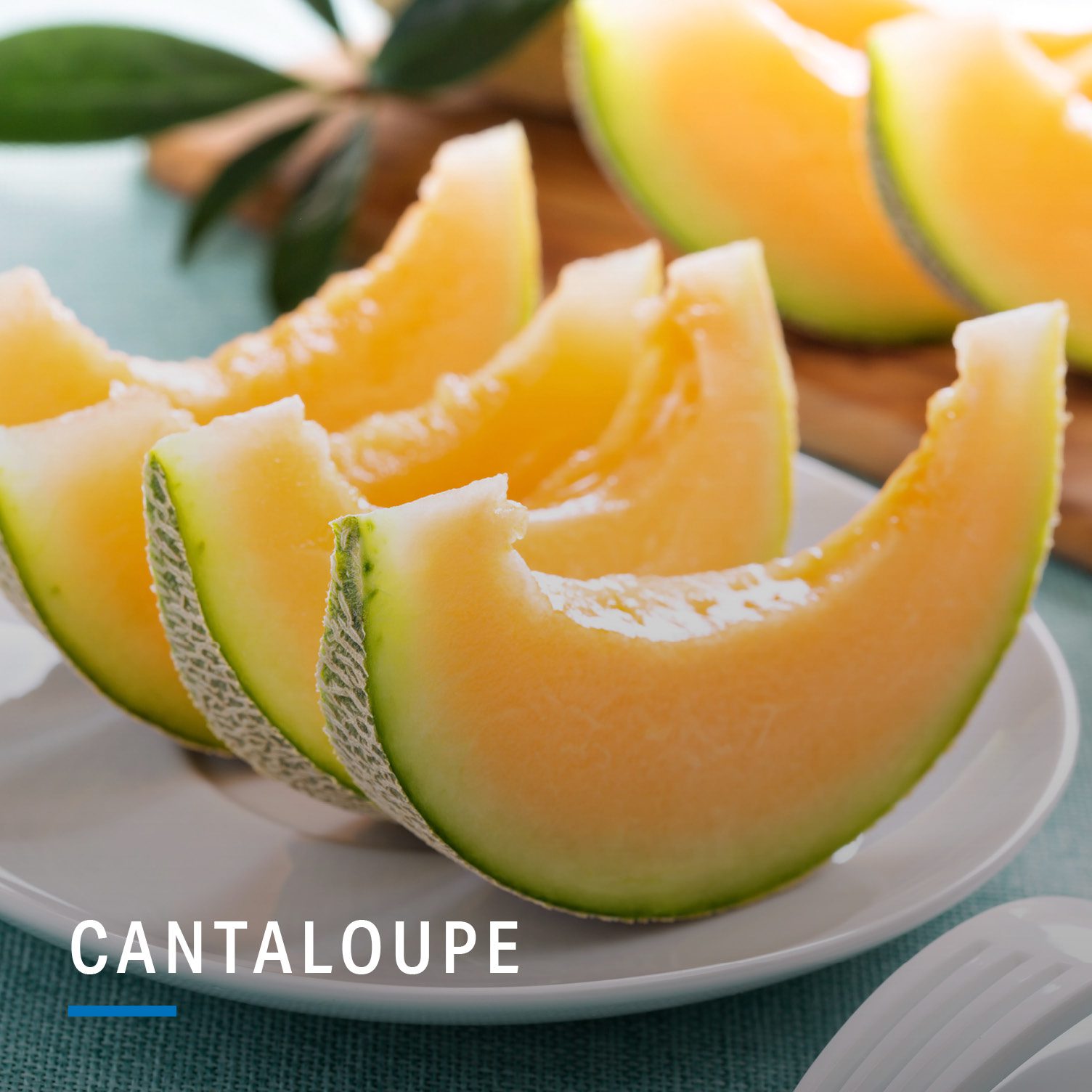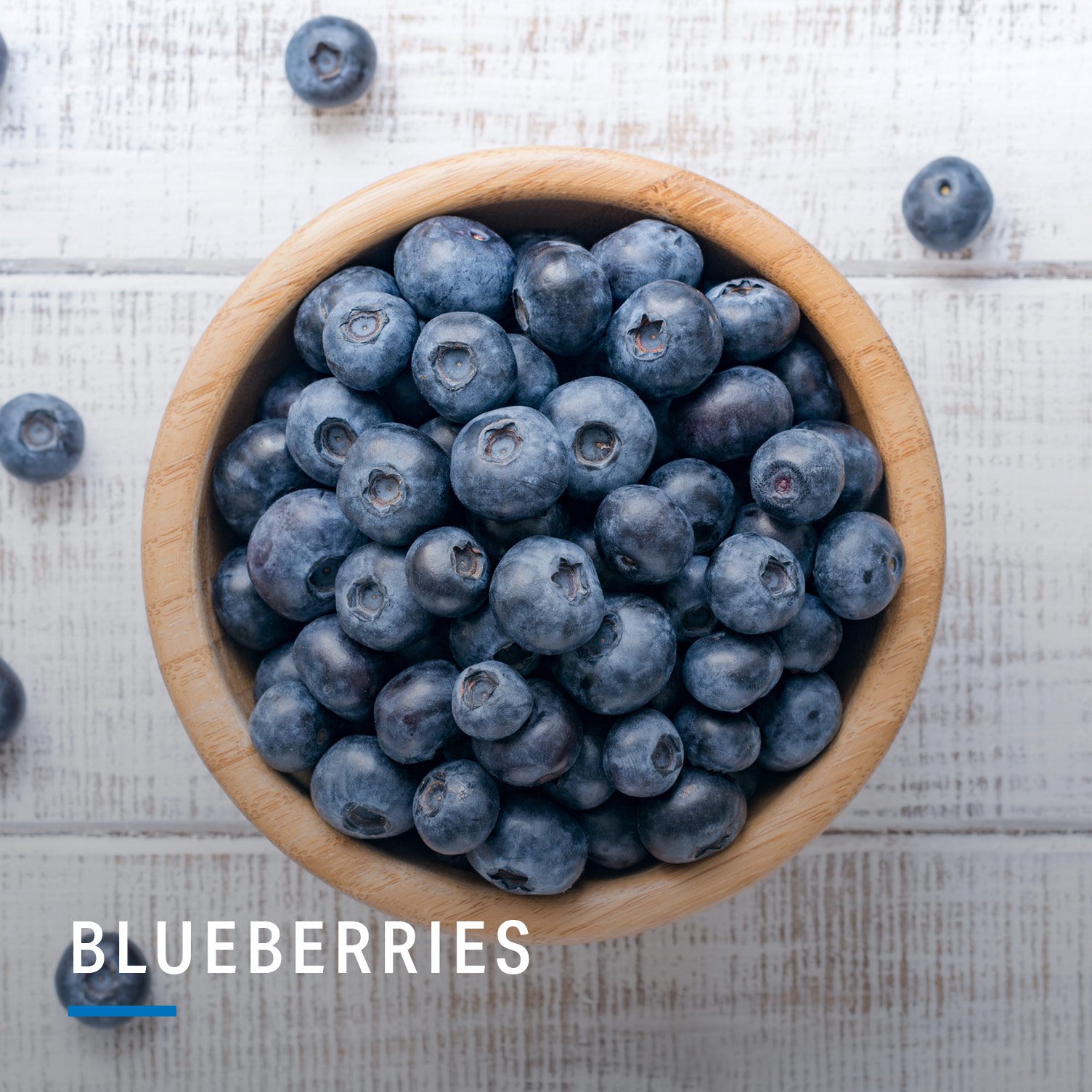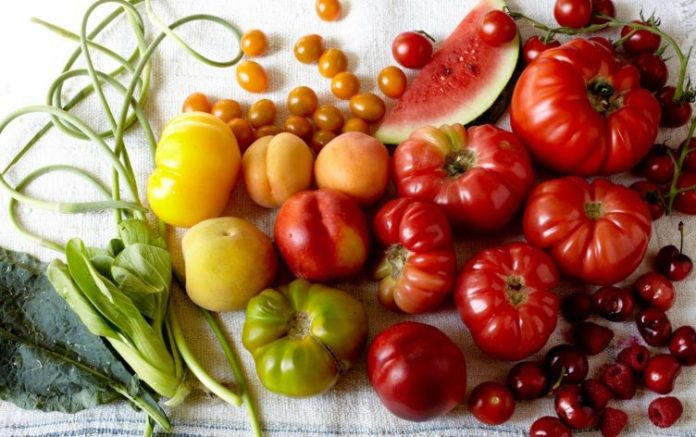
Fresh produce is loaded with vitamins, phytonutrients and fiber, and according to most dietary guidelines, it should take up about half of your plate at each meal. Fortunately, it’s delicious. And if you focus on what’s currently in season, you can eat your favorite produce at its peak nutrition and flavor.
Below, Leslie Bonci, RD, a sports dietitian and owner of Active Eating Advice, shares 10 recommendations to eat right now. Whether you’re browsing the farmers market or pillaging the shelves of your local grocery store, stock up on these fresh fruits and vegetables, from juicy peaches and watermelon to versatile summer squash.
SUMMER FRUITS

Cantaloupe is great on its own, but if you want to go beyond the usual snack, Bonci suggests adding cantaloupe to cottage cheese with a sprinkle of almonds. It makes a quick and refreshing breakfast or lunch, and the protein helps fill you up.
When picking out cantaloupe, look for fruit that feels heavy and has a sweet smell. The stem should yield slightly when pressure is applied with your thumb. Once cut, store cantaloupe in an airtight container in the fridge.
Nutrition: 1 cup of cantaloupe has 54 calories, 13 grams carbs, and 1 gram protein.
CLICK TO TWEET THIS ARTICLE > 10 in-season fruits and veggies you should add to your shopping list according to @MyFitnessPal

Wash some blueberries, keep them nearby, and pop them into your mouth for a satisfying snack. Or add them to a yogurt parfait, blend them into smoothies, or sprinkle a handful on your next salad.
Choose berries that are plump, firm and blue (berries with a red tinge were harvested too early and won’t ripen). Store blueberries in the fridge and wash with cold water just before eating.
Nutrition: 1 cup of blueberries has 84 calories, 21 grams carbs and 1 gram protein.

Apples are a healthy, high-fiber fruit that is great for eating on the go, packing into lunches or slicing and pairing with dip like peanut butter. If you want to get creative during summer barbecues, Bonci suggests using apple slices as the base of a s’more instead of the typical graham cracker. You can also cut up apples and add them to coleslaw for a sweet crunch.
Look for apples that are firm to the touch, with no visible bruising or cuts. They will ripen quickly if left on the counter, so unless you plan to eat them within a couple days, store apples in the crisper drawer of your fridge. Keep them away from foods like onions, as an apple’s thin skin can absorb nearby flavors and odors.
Nutrition: 1 medium apple has 94 calories and 25 grams carbs.

Bonci says one of her favorite dishes is a summer salad made with fresh peaches, fresh mozzarella and basil. You can also grill peaches for a tasty side to grilled meat and vegetables or keep it simple and add fresh peaches to Greek yogurt with a sprinkle of granola.
Gently squeeze a peach to check its ripeness. If it has some give, a vibrant color and enticing fragrance, it should be ready to eat. Hard peaches need a few more days. Store them on the counter until they’re ripe, or try placing them in a paper bag to speed things up.
Nutrition: 1 medium peach has 39 calories, 14 grams carbs and 1 gram protein.

Nothing embodies summer quite like a juicy watermelon. Cut one and serve it at a barbecue, or just keep some around for a hydrating snack. Watermelon is a tasty addition to spinach salads with feta cheese. For a cooling treat, blend watermelon and strawberries into a quick slushy.
When picking out a watermelon, pay attention to its colors. A bright green, shiny-skinned watermelon with a green stem isn’t ripe yet. Instead, look for the “field patch,” which is the light-colored spot where the watermelon sat on the ground. If it’s creamy and yellow, you’re in luck. Once cut, store watermelon in the fridge in an airtight container.
Nutrition: 1 cup of watermelon has 40 calories and 10 grams of carbs.
SUMMER VEGETABLES

Summer tomatoes are a revelation and can be served raw or cooked in a variety of dishes. Slice and serve with salt and pepper for an easy side dish, make a caprese salad with mozzarella and basil, blend them into a fresh gazpacho, or roast them in the oven. You can’t go wrong with good tomatoes.
Choose tomatoes that feel firm in your hand, with some give, and have a pleasant aroma near the stem. Avoid tomatoes with visible blemishes and dark spots. Store tomatoes stem-side down at room temperature and eat them at the peak of ripeness. If you must put your tomatoes in the fridge, try not to leave them in there for more than a couple of days (cold can degrade the flesh). Bring them up to room temp before eating.
Nutrition: 1 medium tomato has about 25 calories and 5 grams carbs.

A versatile summer veggie, summer squashes are bountiful this time of year. “I love it grilled with roasted peppers, mushrooms and onions,” says Bonci. She also suggests adding squash to kebabs, or try air-frying them with panko bread crumbs for a fun, healthy take on the fried zucchini popular at bars. Add a squeeze of lemon before you serve for a citrusy kick.
Select zucchini that is firm to the touch, with a portion of the stem still intact. Keep zucchini in the fridge — it can last up to two weeks in the crisper drawer — and don’t wash it until you’re ready to eat it.
Nutrition: 1 cup zucchini has 19 calories, 3 grams carbs and 1 gram protein.

Chop raw green beans and add them to salad, with red onion, tomatoes and yellow peppers. Saute in a pan with garlic or add green beans to your veggie tray with dip.
Choose green beans that are firm and crisp — they should snap cleanly in your hands. Store unwashed in a plastic bag in your crisper drawer for up to a week. Rinse with cold water and drain thoroughly before eating.
Nutrition: 1 cup green beans has 34 calories, 8 grams carbs and 2 grams protein.

“I love the mini ones as dippers for hummus or Greek yogurt with dill,” says Bonci. You can also roast bell peppers in the oven for a quick side dish, dice them into salads, or cool down with a red pepper and peach gazpacho.
Pick bell peppers with a deep color and glossy sheen, absent of any blemishes or soft spots. They will last for a few days on the counter, but bell peppers prefer the cool environment of your fridge. Store them in your crisper drawer for up to two weeks.
Nutrition: 1 red bell pepper has 39 calories, 9 grams carbs and 1 gram protein.

Beets — roasted, raw and pickled — are a great addition to salads, adding a punch of flavor to arugula with a citrus vinaigrette. For a quick hit of vitamins, you can also juice beets with apples and other produce, or make a healthy smoothie with beets, spinach, pineapple juice and berries.
Choose beets that are very firm, with a deep maroon color and bright green leaves. Store them loose and unwashed in the fridge for 2–3 weeks. The greens degrade faster than the beet itself, so these may need to be cut away if they start to wilt or spoil.
Nutrition: 1 cup beets has 58 calories, 13 grams carbs and 2 grams protein.
THE BOTTOM LINE
We should all strive to eat plenty of fruits and vegetables, whether they’re fresh or roasted, and whether they’re served as the star of the show or one component of a dish. Fortunately, each season is an opportunity to try new foods and eat produce at its peak. This summer, become a regular at your local market, and enjoy the delicious bounty that nature provides.
Make progress every day while you work on mini fitness and nutrition goals, like walking more steps or learning to track macros. Go to “Plans” in the MyFitnessPal app for daily coaching and easy-to-follow tasks to keep you motivated.












